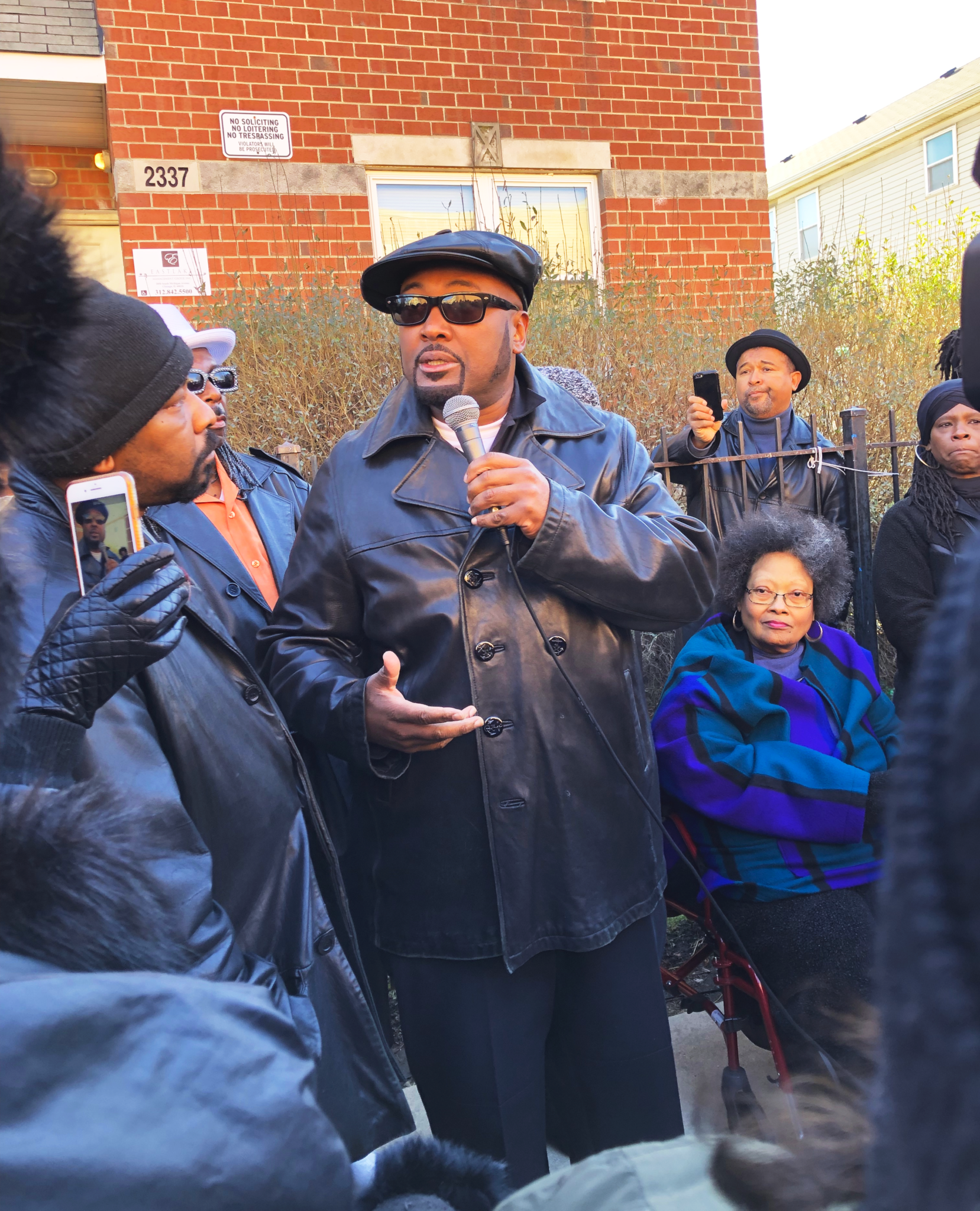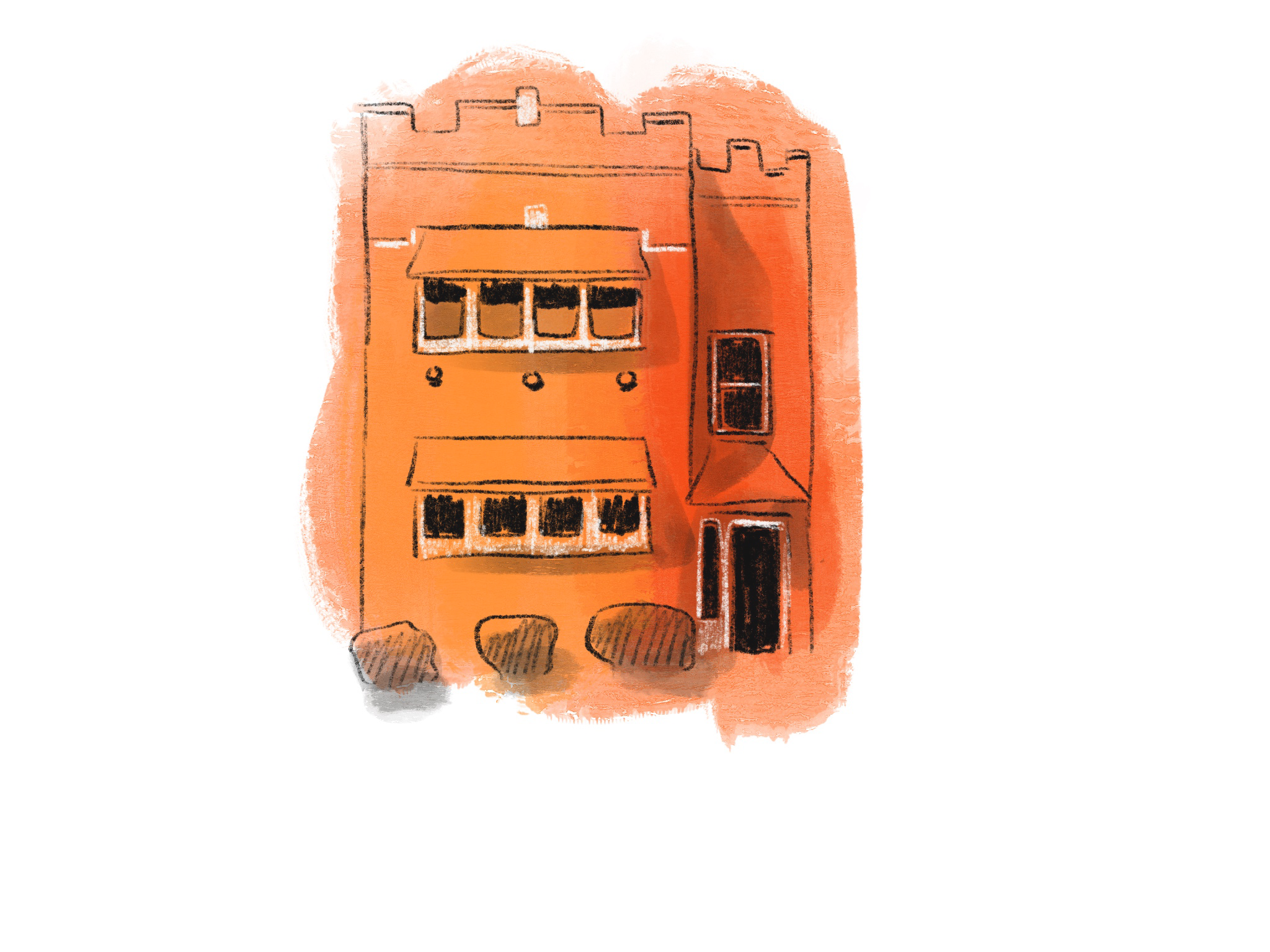On a recent cold December day, a crowd of activists, journalists, and Black Panthers gathered in front of 2337 West Monroe Street, two blocks west of the United Center, to remember the fifty-year anniversary of the West Side police raid that killed Illinois Black Panther Party Chairman Fred Hampton and Defense Captain Mark Clark. The original house was demolished years ago and replaced by a modern brick two-flat.
The vigil was one event amid a week’s worth of tributes, fundraisers, and musical performances remembering December 4, 1969, the night Hampton was shot to death by police. Its organizers, led by son Fred Hampton Jr., sought not only to memorialize Hampton, but also to continue the “Save the Hampton House” campaign, an activist push to save Hampton’s suburban childhood residence from auction.
While the vigil was at times somber, focusing on the injustice of Hampton’s assassination, recalling its details, and holding a five-minute moment of silence with raised fists, its tone was overwhelmingly resilient: former Black Panther Party (BPP) members, current BPP Cubs members, and other activists look to the legacy of Hampton to confront violence directed at the Black community today, both in the city and the world at large.
REMEMBERING THE SHOOTING
If you’ve ever been under gunfire, five minutes is five hours,” said Akua Njeri to the crowd assembled at the fiftieth anniversary vigil. Njeri, formerly named Deborah Johnson, was engaged to Hampton and carrying his child at the time of his death. She spoke about her relationship with Hampton, the Black Panther Party’s programs in Chicago, and December 4, 1969.
Recounting the night of the raid at 2337 West Monroe, which served as the home of Hampton and Njeri and was frequented by other BPP members, Njeri recalled lying next to Hampton in bed as he drifted off to sleep, talking on the phone. As the raid started in the early hours of the morning, another Panther rushed in to alert Hampton that the police were in the building and shooting, but Hampton could not be awakened, Njeri said. It would later be revealed that he had been drugged by a fellow Panther and FBI informant.
The shooting stopped only momentarily when another Panther shouted out that Njeri was pregnant. She stumbled into the kitchen with her hands up, hoping she would survive, she recalled. Soon after, police entered the bedroom where an unconscious Hampton lay, and continued firing. With tears in her eyes, Njeri recalled an officer remarking, “He’s good and dead now.”
In the end, twenty-one-year-old Hampton and twenty-two-year-old Clark, who had been guarding the front door, lay dead. Police initially charged the seven survivors with unlawful use of weapons, aggravated assault, and attempted murder and held them on $100,000 bond, according to press reports. Four of the survivors were taken to the hospital and the other three went to Cook County Jail. After their bond was lowered, they were able to leave the jail and in May of 1970 the charges were dropped.
Though Hampton and Clark’s deaths were initially ruled “justifiable homicides,” a thirteen-year-long civil rights case was settled in 1982 that proved a conspiracy and yielded $1.85 million on behalf of the survivors and family members of those killed.
Black Panthers present at the West Side raid, dubbed the “Massacre on Monroe,” did not need the settlement to establish what they already knew: the raid was an assassination carried out by the Chicago Police Department that formed part of an illegal FBI operation named COINTELPRO that sought to target, surveil, discredit, and divide prominent leftist political groups like the Black Panther Party. The FBI in Chicago had monitored the BPP since the branch’s opening and an FBI informant had provided the CPD with a diagram of the apartment, the investigation found.
At the anniversary vigil, Fred Hampton’s son, a survivor himself, also spoke about the killings, although his vantage point was quite different: “Chicago Police put the pistol to my comrade mother’s stomach. The first piece of steel I ever felt… as opposed to the doctor’s stethoscope, was the Chicago Police Department’s revolver.”
Fred Hampton Jr., who is now the current Chairman of the Black Panther Party Cubs, described the site of Hampton’s assassination as the Black community’s “Ground Zero”—the location where the twin towers of Mark Clark and Chairman Fred fell in a single terrorist attack.

He spoke at length about his father’s legacy, the crucial work the BPP performed in underfunded Black neighborhoods in Chicago, and the issues that plagued the Black community then and remain today. The fight to “Save the Hampton House” is itself still central to the activism of Hampton Jr. and others, for the house is and has been a site of Black self-empowerment, conflict resolution, and community aid for decades. Its current protectors seek to enshrine it as a continued home base from which to build the type of future that Hampton and his BPP of old fought for.
SAVE THE HAMPTON HOUSE
The fight to save Fred Hampton’s childhood home is, in the words of his son, “bigger than a building.” While it is a fight to save the physical home, it is also a fight to preserve the legacy of Hampton’s work, a legacy which has a great deal to contribute to the community it inhabits.
Maywood, a western suburb, is a mostly Black working-class community of around 24,000. Though small, it has a storied past: Maywood was home to a safe house for runaway slaves along the Underground Railroad and later sent eighty-nine men from its Tank Battalion to fight in World War II.
The Hampton house is a key part of Maywood’s history. Fred Hampton’s family moved to the house at 804 South 17th Avenue in 1958, when he was only ten years old. Hampton’s childhood experiences would lay the groundwork for his extraordinary political leadership. At Irving Middle School, across the street from his home, Hampton ran morning homework sessions. As a fourteen-year-old, he organized a student chapter of the Maywood NAACP, and in high school he led activist committees and campaigns at nearby Proviso East High School.
Merely two years after graduating high school, in December of 1968, Hampton became chairman of the Chicago Black Panthers, a chapter that ran free medical clinics, formed key interracial links with other Chicago groups like the Young Lords and Young Patriots under the banner of the Rainbow Coalition, and served up to 4,000 free breakfast meals daily. Soon after, he assumed the chairmanship of the Illinois BPP at-large and under his direction, it would become the largest and most powerful chapter nationwide, according to a history published in December by the Maywood-based Village Free Press.
As Hampton’s influence and prestige increased, he more and more became a target of FBI informants, CPD raids, and trumped-up charges. On December 4th, 1969, his brilliant revolutionary life came to a tragic end. Fifty years later, the house in which he grew up is locked up in its own fight for existence.
While the family briefly saved the house from foreclosure in October 2018 with the help of activists, the threat of losing the house still looms large. Members of the Hampton family found out about the looming foreclosure merely a month before the scheduled auction date that October, the Village Free Press reported in 2018. Faced with $71,000 in debt to US Bank from an adjustable subprime loan taken out by Hampton Jr.’s grandparents in 2007, the family needed to raise money quickly.
Since foreclosure cases often take more than a year and banks are required to negotiate with the owner as a result of the 2008 financial crisis, the auction was stalled, according to Mario Reed, the former director of public information for the Cook County Recorder of Deeds, who was interviewed in 2018 about the house. Community members and activists have scrambled to raise the funds necessary to stall the foreclosure threat once and for all, and to upgrade the house and turn it into a full-scale museum
The family created an organization by the name of Save the Hampton House as well as a GoFundMe that, as of press time, has raised $153,982 out of a goal of $350,000. An additional goal of the GoFundMe campaign is to upgrade the museum and make it into a more modern, comprehensive place of learning.
The community is at risk of losing a key actor that mediates disputes, serves as a base for Black Panther Party Cubs programming like free breakfast and clothing, and hosts birthdays and other community events. The house is also a beacon of Black pride for students, such as those at Hampton’s alma mater, Irving Middle School. Hampton Jr. pointed out that the house has had a positive effect on the students’ self-worth, knowledge of history, and politicization. “You can see the physical transformation: you can see their walk’s even different, their heads are held higher, their chests stick out,” he said.
Channeling the legacy of the BPP, the museum, as it has existed so far, depends on community itself. Hampton Jr. makes clear that the “people who come are not only receiving information but giving information.” Members of the community who visit the house have found Hampton Jr. to tell him their memories of Chairman Fred, detail how his life affected them, and bring photos to share for exhibition.
Part of the work to save the house is also focused on its physical structure, working on the interior and exterior to bring it back up to code. In this work, too, the house has been served by the community, both young and old, whether it be a house painter who worked on it for free or the time a seventy-two-year-old man was so awestruck by the dishes that Hampton used to eat on that he made sure they weren’t thrown away. The house is a space which brings generations together.
While in need of funds and repairs, and in the absence of the Panther house on West Monroe St., the Maywood home’s present and future rests in good hands—as Hampton Jr. put it, “the people have been keeping us alive.”
Gabe Levine-Drizin is a contributor to the Weekly. He last wrote about state legislative efforts to eliminate and reform gang databases in October.

